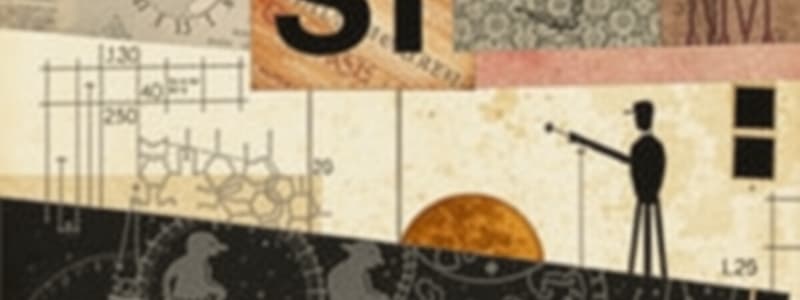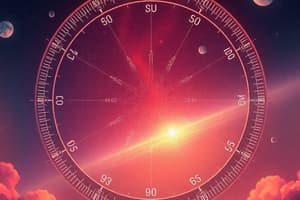Podcast
Questions and Answers
Which system of measurement is primarily used by scientists?
Which system of measurement is primarily used by scientists?
- English system
- Metric system
- Imperial system
- International System of Units (SI) (correct)
What is the basic unit of mass in the SI system?
What is the basic unit of mass in the SI system?
- pound (lb)
- gram (g)
- milligram (mg)
- kilogram (kg) (correct)
What unit is commonly used to measure temperature in the metric system?
What unit is commonly used to measure temperature in the metric system?
- Rankine (°R)
- Kelvin (K)
- Celsius (°C) (correct)
- Fahrenheit (°F)
Which of the following lengths is equivalent to 1 meter?
Which of the following lengths is equivalent to 1 meter?
What is the unit for volume in the SI system?
What is the unit for volume in the SI system?
Which measurement corresponds to the longest distance?
Which measurement corresponds to the longest distance?
What does the molecular formula represent?
What does the molecular formula represent?
Which of the following is an example of an empirical formula?
Which of the following is an example of an empirical formula?
What is indicated by a single line in a structural formula?
What is indicated by a single line in a structural formula?
Which type of compounds are NOT represented using structural formulas?
Which type of compounds are NOT represented using structural formulas?
What are the two common molecular models used to represent molecules?
What are the two common molecular models used to represent molecules?
What is the empirical formula for a compound containing 4 carbon atoms and 8 hydrogen atoms?
What is the empirical formula for a compound containing 4 carbon atoms and 8 hydrogen atoms?
Which formula type provides insights into how atoms are bonded together?
Which formula type provides insights into how atoms are bonded together?
Which of the following is considered an atomic element?
Which of the following is considered an atomic element?
What is the net ionic equation for the reaction between NaOH and HCl?
What is the net ionic equation for the reaction between NaOH and HCl?
Which type of bond involves the transfer of electrons between atoms?
Which type of bond involves the transfer of electrons between atoms?
What type of bond is formed by sharing electron pairs between two atoms?
What type of bond is formed by sharing electron pairs between two atoms?
Which of the following represents a double covalent bond?
Which of the following represents a double covalent bond?
What occurs in the net ionic equation for the reaction of silver nitrate with hydrochloric acid?
What occurs in the net ionic equation for the reaction of silver nitrate with hydrochloric acid?
In terms of potential energy, how do chemical bonds primarily function?
In terms of potential energy, how do chemical bonds primarily function?
What is the formula mass of water (H2O)?
What is the formula mass of water (H2O)?
What is the molar mass of glucose (C6H12O6)?
What is the molar mass of glucose (C6H12O6)?
Which statement about molar mass is true?
Which statement about molar mass is true?
In a chemical equation, what are the substances initially involved called?
In a chemical equation, what are the substances initially involved called?
What does a chemical equation represent?
What does a chemical equation represent?
How is the molar mass of a substance calculated?
How is the molar mass of a substance calculated?
What is the molar mass of oxygen gas (O2)?
What is the molar mass of oxygen gas (O2)?
What are the products of a chemical reaction?
What are the products of a chemical reaction?
Which of the following formulas represents the molar mass calculation for sodium chloride (NaCl)?
Which of the following formulas represents the molar mass calculation for sodium chloride (NaCl)?
What is the correct chemical equation notation for the transformation of substances A and B into product AB?
What is the correct chemical equation notation for the transformation of substances A and B into product AB?
Study Notes
Units of Measurement
- Measurements are used in everyday life.
- Units are used in the metric and International System of Units (SI) to specify measurements.
- The English system is used in the United States.
- The metric system is used in most countries.
- The SI system is used by scientists and is based on the metric system.
Measurements
- Length is measured using a meter stick in both the metric and SI systems.
- Volume is measured in liters (L) in the metric system and cubic meters (m3) in the SI system.
- Mass is measured in grams (g) in the metric system and kilograms (kg) in the SI system.
- Temperature is measured in Celsius (°C) in the metric system and Kelvin (K) in the SI system.
- Time is measured in seconds (s) in both the metric and SI systems.
Mass
- Mass of an object is the amount of matter in it.
- Ionic compounds are represented using their Empirical Formulas.
Chemical Formulas
- Molecular Formula gives the actual number of atoms of each element in a molecule.
- Structural Formula shows how atoms in a molecule are bonded together.
- Molecular Models include Ball-and-Stick Model and Space-Filling Model.
Atomic Level View of Elements and Compounds
- Atomic Elements are elements whose particles are single atoms.
- Formula Mass is the sum of the masses of the atoms in a single molecule or formula unit.
- Molar Mass is the mass of one mole of a substance, expressed in g/mol.
Chemical Reactions
- A chemical reaction is a process that transforms one set of substances into another.
- Reactants are substances initially involved in a chemical reaction.
- Products are substances produced by a chemical reaction.
Chemical Equations
- Chemical Equation is a shorthand way to describe a chemical reaction.
- Net Ionic Equation is the chemical equation that shows only the ions that participate in the reaction.
Chemical Bonds
- Chemical Bonds hold atoms together in compounds.
- Chemical bonds form due to attractions between protons and electrons of bonded atoms.
- Chemical bonds lower the potential energy between charged particles in atoms.
Types of Chemical Bonds
- Ionic Bonds form when electrons are transferred, resulting in oppositely charged ions that attract each other.
- Covalent Bonds form when atoms share electrons.
- Metallic Bonds form between metal atoms.
Intermolecular Forces
- Intermolecular Forces (IMF) are weak attractions between molecules.
- IMF affect the rate and outcome of chemical reactions.
Types of Intermolecular Forces
- London Dispersion Forces are weak interactions due to momentary changes in electron density in a molecule.
- Dipole-dipole interactions are attractive forces between permanent dipoles of polar molecules.
- Hydrogen Bonding is a strong type of dipole-dipole interaction that occurs between molecules containing hydrogen bonded to oxygen, nitrogen, or fluorine.
Intermolecular Hydrogen Bonding
- Intermolecular hydrogen bond occurs between two molecules with hydrogen located between two electronegative groups.
Studying That Suits You
Use AI to generate personalized quizzes and flashcards to suit your learning preferences.
Related Documents
Description
Explore the essential units of measurement used in everyday life, focusing on the metric and SI systems. This quiz covers length, volume, mass, temperature, and time, providing insights into how different systems are employed globally and scientifically.




